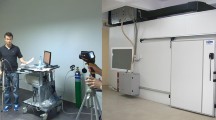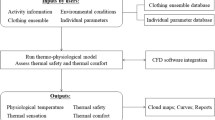Abstract
The purpose of this paper is to implement current and novel research techniques in human energy budget estimations to give more accurate and efficient application of models by a variety of users. Using the COMFA model, the conditioning level of an individual is incorporated into overall energy budget predictions, giving more realistic estimations of the metabolism experienced at various fitness levels. Through the use of VO2 reserve estimates, errors are found when an elite athlete is modelled as an unconditioned or a conditioned individual, giving budgets underpredicted significantly by −173 and −123 W m−2, respectively. Such underprediction can result in critical errors regarding heat stress, particularly in highly motivated individuals; thus this revision is critical for athletic individuals. A further improvement in the COMFA model involves improved adaptation of clothing insulation (I cl), as well clothing non-uniformity, with changing air temperature (T a) and metabolic activity (M act). Equivalent T a values (for I cl estimation) are calculated in order to lower the I cl value with increasing M act at equal T a. Furthermore, threshold T a values are calculated to predict the point at which an individual will change from a uniform I cl to a segmented I cl (full ensemble to shorts and a T-shirt). Lastly, improved relative velocity (v r) estimates were found with a refined equation accounting for the degree angle of wind to body movement. Differences between the original and improved v r equations increased with higher wind and activity speeds, and as the wind to body angle moved away from 90°. Under moderate microclimate conditions, and wind from behind a person, the convective heat loss and skin temperature estimates were 47 W m−2 and 1.7°C higher when using the improved v r equation. These model revisions improve the applicability and usability of the COMFA energy budget model for subjects performing physical activity in outdoor environments. Application is possible for other similar energy budget models, and within various urban and rural environments.




Similar content being viewed by others
References
ACSM (2006) ACSM’s guidelines for exercise testing and prescription., 7th edn Lippincott Williams and Wilkins, Baltimore
Ainsworth BE, Haskell WL, Whitt MC, Irwin ML, Swartz AM, Strath SJ, O’Brien WL (2000) Compendium of physical activities: an update of activity codes and MET intensities. Med Sci Sport Exer 32(9):498–516
Arens E, Zhang H, Huizenga C (2006) Partial- and whole-body thermal sensation and comfort—part II: non-uniform environmental conditions. J Therm Biol 31:60–66
Basu R, Samet JM (2002) Relation between elevated ambient temperature and mortality: a review of the epidemiologic evidence. Epidemiol Rev 24(2):190–202
Ben Shabat Y, Shitzer A (2011) Facial convective heat exchange coefficients in cold and windy environments estimated from human experiments. Int J Biometeorol. doi: 10.1007/s00484-011-0463-0
Brotherhood JR (2008) Heat stress and strain in exercise and sport. J Sci Med Sport 11(1):6–19
Brown RD, Gillespie TJ (1986) Estimating outdoor thermal comfort using a cylindrical radiation thermometer and an energy budget model. Int J Biometeorol 30(1):43–52
Bulcao CF, Frank SM, Raja SN, Tran KM, Goldstein DS (2000) Relative contribution of core and skin temperatures to thermal comfort in humans. J Therm Biol 25(1–2):147–150
Campbell GS, Norman JM (1998) An introduction to environmental bio-physics, 2nd edn. Springer, New York
deDear RJ, Brager GS (1998) Developing an adaptive model of thermal comfort and preference. ASHRAE Trans 104(1a):145–167
Djongyang N, Tchinda R, Njomo D (2010) Thermal comfort: a review paper. Renew Sust Energ Rev 14:2626–2640
Donaldson GC, Rintamaki H, Nayha S (2001) Outdoor clothing: its relationship to geography, climate, behaviour and cold-related mortality in Europe. Int J Biometeorol 45:45–51
Donaldson GC, Tchernjavskii VE, Ermakov SP (1998) Winter mortality and cold stress in Yekaterinburg, Russia: interview survey. Br Med J 316:514–518
Eliasson I, Knez I, Westerberg U, Thorsson S, Lindberg F (2007) Climate and behaviour in a Nordic city. Landsc Urban Plann 82(1–2):72–84
Epstein Y, Moran DS (2006) Evaluation of the environmental stress index (ESI) for hot/dry and hot/wet climates. Ind Health 44(3):399–403
Fiala D, Lomas KJ, Stohrer M (2001) Computer prediction of human the-moregulatory and temperature responses to a wide range of environmental condi-tions. Int J Biometeorol 45:143–159
Fiala D, Lomas KJ, Stohrer M (2003) First principles modelling of thermal sensation responses in steady state and transient boundary conditions. ASHRAE Trans 109(1):179–186
Galea S, Vlahov D (2005) Urban health: evidence, challenges and directions. Annu Rev Public Health 26(1):341–365
Goodwin J, Taylor RS, Pearce VR, Read KL (2000) Seasonal cold, excur-sional behaviour, clothing protection and physical activity in young and old subjects. Int J Circumpolar Health 59(3–4):195–203
Gosling SN, McGregor GR, Paldy A (2007) Climate change and heat-related mortality in six cities Part 1: model construction and validation. Int J Biometeorol 51:525–540
Havenith G (1997) Individual heat stress response. PhD thesis, Catholic University Nijmegen. Springer, Heidelberg
Havenith G, Fiala D, Blazejczyk K, Richards M, Bröde P, Holmér I, Rintamaki H, Benshabat Y, Jendritzky G (2011) The UTCI-clothing model. Int J Biometeorol. Special Issue (UTCI). doi: 10.1007/s00484-011-0451-4
Havenith G, Heus R, Lotens W (1990a) Resultant clothing insulation: a function of body movement, posture, wind, clothing fit and ensemble thickness. Ergonomics 33:66–84
Havenith G, Heus R, Lotens WA (1990b) Clothing ventilation, vapour resistance and permeability index: changes due to posture, movement and wind. Ergonomics 33(8):989–1005
Havenith G, Holmer I, Parsons KC (2002) Personal factors in thermal comfort assessment: clothing properties and metabolic heat production. Energ Build 34(6):581–591
Havenith G, Nilsson HO (2004) Correction of clothing insulation for movement and wind effect, a meta-analysis. Eur J Appl Phys 92:636–640
Holmer I, Gavhed DCE (1991) Resultant clothing insulation during exercise in cold. Arch Med Res 50(6):84–98
Holmer I, Parsons KC (1999) Clothing convective heat exchange—proposal for improved prediction in standards and models. Ann Occup Hyg 43:329–337
Hoppe P (2002) Different aspects of assessing indoor and outdoor thermal comfort. Energ Buildings 34(6):661–665
Huang J (2007) Prediction of air temperature for thermal comfort of people in outdoor environments. Int J Biometeorol 51(5):375–382
Huizenga C, Hui Z, Arens E (2001) A model of human physiology and comfort for assessing complex thermal environments. Build Environ 36(6):691–699
ISO9920 (2007) ISO 9920: Ergonomics of the thermal environment: estimation of thermal insulation and water vapour resistance of a clothing ensemble. ISO, Geneva
Jendritzky G (2004) Towards a universal thermal climate index (UTCI) for assessing the thermal environment of the human being. Technical report, European Concerted Research Action—COST 730
Johansson E, Rohinton E (2006) The influence of urban design on outdoor thermal comfort in the hot, humid city of Colombo, Sri Lanka. Int J Biometeorol 51:119–133
Kenny NA, Warland JS, Brown RD, Gillespie TJ (2008) Estimating the radiation absorbed by a human. Int J Biometeorol 52(6):491–503
Kenny NA, Warland JS, Brown RD, Gillespie TJ (2009a) Part A: assessing the performance of the COMFA outdoor thermal comfort model on subjects performing physical activity. Int J Biometeorol 53:415–428
Kenny NA, Warland JS, Brown RD, Gillespie TJ (2009b) Part B: revisions to the COMFA outdoor thermal comfort model for application to subjects performing physical activity. Int J Biometeorol 53:429–441
Mäkinen T, Raatikka V, Rytkönen M, Jokelainen J, Rintamäki H, Ruuhela R, Näyhä S, Hassi J (2006) Factors affecting outdoor exposure in winter: population-based study. Int J Biometeorol 51:27–36. doi:10.1007/s00484-006-0040-0
Monteith JL, Unsworth MH (1990) Principles of environmental physics, 2nd edn. Butterworth-Heinemann, New York
Nielsen R, Olesen BW, Fanger PO (1985) Effect of physical activity and air velocity on the thermal insulation of clothing. Ergonomics 28:1617–1631
Parsons K (2003) Human thermal environments: the effects of hot, moderate and cold environments on human health, comfort and performance, 2nd edn. Taylor and Francis, New York, NY
Psikuta A, Fiala D, Laschewski G, Jendritzky G, Richards M, BlaŻejczyk K, Mekjavič I, Rintamäki H, de Dear R, Havenith G (2011) Validation of the Fiala multi-node thermophysiological model for UTCI application. Int J Biometeorol. Special Issue (UTCI). doi: 10.1007/s00484-011-0450-5
Roberts WO (2007) Heat and cold: what does the environment do to marathon injury? Sports Med 37(4/5):400–403
Shibasaki M, Wilson TE, Crandall CG (2006) Neural control and mechanisms of eccrine sweating during heat stress and exercise. J Appl Physiol 100(5):1692–1701
Smoyer KE, Rainham DGC, Hewko JN (2000) Heat-stress-related mortality in five cities in Southern Ontario: 1980–1996. Int J Biometeorol 44:190–197
Souch CA, Souch C (1993) The effect of trees on summertime below canopy urban climates: a case study Bloomingdale, Indiana. J Arboric 19(5):303–312
Strath SJ, Swartz AM, Basset DR, O’Brien WL, King GA, Ainsworth BE (2000) Evaluation of heart rate as a method for assessing moderate intensity physical activity. Med Sci Sport Exer 32(9):S465–S470
Tanabe S, Kobayashi K, Nakano J, Ozeki Y, Konishi M (2002) Evaluation of thermal comfort using combined multi-node thermoregulation (65MN) and radiation models and computational fluid dynamics (CFD). Energ Build 34(6):637–646
The Eurowinter Group (1997) Cold exposure and winter mortality from ischaemic heart disease, cerebrovascular disease, respiratory disease, and all causes in warm and cold regions of Europe. Lancet 349:1341–1346
Tikuisis P, Meunier P, Jubenville C (2001) Human body surface area: measurement and prediction using three dimensional body scans. Eur J Appl Phys 85(3–4):264–271
Tucker R, Marle T, Lambert EV, Noakes TD (2006) The rate of heat storage mediates an anticipatory reduction in exercise intensity during cycling at a fixed rating of perceived exertion. J Physiol 574(3):905–915
UTCI (2010) Universal thermal climate index. Online: http://www.utci.org/index.php
Vanos JK, Warland JS, Kenny NA, Gillespie TJ (2010a) Review of the physiology of human thermal comfort while exercising in urban landscapes and implications for bioclimatic design. Int J Biometeorol 54(4):319–334
Vanos J, Warland J, Gillespie T, Kenny N (2010b) Thermal comfort mod-elling of body temperature and psychological variations of a human exercising in an outdoor environment. Int J Biometeorol, pages [Online First, 1-12]. 10.1007/s00484-010-0393-2
Watkins R, Palmer J, Kolokotromi M (2007) Increased temperature and intensification of the Urban Heat Island: implications for human comfort and urban design. Built Environ 33(1):85–96
Yao Y, Lian Z, Liu W, Shen Q (2007) Experimental study on skin tempera-ture and thermal comfort of the human body in a recumbent posture under uniform thermal environments. Indoor Built Environ 16(6):505
Yao R, Li B, Liu J (2009) A theoretical adaptive model of thermal comfort—Adaptive Predicted Mean Vote (aPMV). Build Environ 44(10):2089–2096
Zolfaghari A, Maerefat M (2010) A new simplified model for evaluating non-uniform thermal sensation caused by wearing clothing. Build Environ 45:776–783
Author information
Authors and Affiliations
Corresponding author
Rights and permissions
About this article
Cite this article
Vanos, J.K., Warland, J.S., Gillespie, T.J. et al. Improved predictive ability of climate–human–behaviour interactions with modifications to the COMFA outdoor energy budget model. Int J Biometeorol 56, 1065–1074 (2012). https://doi.org/10.1007/s00484-012-0522-1
Received:
Revised:
Accepted:
Published:
Issue Date:
DOI: https://doi.org/10.1007/s00484-012-0522-1




